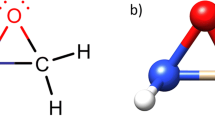Abstract
The general principles of the electronic structure of molecules and complexes are discussed. An analysis of photoelectron and x-ray photoelectron spectra reveals that in most cases, the interaction of the valence AO's results in the formation of delocalized MO's, which are populated by electrons, but are not bonding according to their energies (molecules with small atomic cores are exceptions). These MO's do not make a positive contribution to the exothermic effect of chemical bonding. The delocalization of the valence electrons in such MO's reduces their charge density in the region of the atomic cores and lowers the energy of the inner “atoms-in-molecules” levels as a result of the reduction of the internal shielding; the ESCA shifts of the inner electronic levels confirm this stabilization. In accordance with the virial theorem, the lowering of the energy of the core levels of the central atoms (with simultaneous, generally small changes in the energy of the core levels of the ligands and despite the significant destabilization of the delocalized MO's in comparison to the valence orbitals of the corresponding free atoms) makes up the main contribution to the energy of chemical bonds.
Similar content being viewed by others
Literature cited
G, P. Kostikova, Yu. P. Kostikov, and D. V. Korol'kov, “Principles of the electronic structure of complexes of nontransition elements,” Dokl. Akad. Nauk SSSR, 280, No. 3, 663–666 (1985).
K. Ruedenberg, “Physical nature of the chemical bond,” Rev. Möd. Phys., 34, 326–376 (1962).
R. L. Barinskii and V. I. Nefedov, X-Ray-Spectroscopic Determination of the Charges of Atoms in Molecules [in Russian], Nauka, Moscow (1966).
K. Ruedenberg, “An approximate relation between orbital SCF energies and total SCF energy in molecules,” J. Chem. Phys., 66, No. 1, 375–376 (1977).
Yu. L. Slovokhotov, M. Yu. Antipin, R. G. Gerr, et al., “Experimental investigation of the distribution of the electron density in the tetrahedral chromium cluster (η5C5H4Me)4Cr4(μ3-S)4,” Dokl. Akad. Nauk SSSR, 285, No. 6, 1413–1418 (1985).
E. Kraka, Neue Wege zur Analyse der Elektronendichteverteilung in Molekülen, Universität zu Köln, Cologne (1984).
Yu. A. Teterin, S. G. Gagarin, Yu. P. Dikov, and G. L. Gutsev, “Contribution of the electrons in the valence and inner moelcular orbitals to the energy of the chemical bond of the nitrogen molecule,” Dokl. Akad. Nauk SSSR, 268 No. 4, 921–924 (1983).
C. A. Coulson, Valence, Oxford Univ. Press, New York-London (1961).
Dao-Kai Pan, Ze-Fu Niu, Jian-Nan Gao, and San-Lin Liu, “Some new concepts on the nature of the covalent bond based on abinitio quantum-chemical calculations,” Int. J. Quant. Chem., 23, No. 6, 1945–1958 (1983).
Author information
Authors and Affiliations
Additional information
This article is being published for purposes of discussion.
Translated from Teoreticheskaya i Éksperimental'naya Khimiya, Vol. 22, No. 5, pp. 572–578, September–October, 1986.
Rights and permissions
About this article
Cite this article
Kostikova, G.P., Kostikov, Y.P. & Korol'kov, D.V. Role of core and valence atomic orbitals in the formation of chemical bonds. Theor Exp Chem 22, 544–550 (1987). https://doi.org/10.1007/BF00522539
Received:
Issue Date:
DOI: https://doi.org/10.1007/BF00522539




